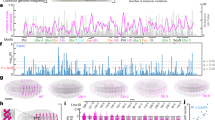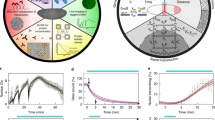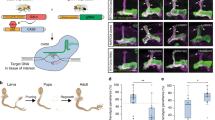Abstract
The development of two-component expression systems in Drosophila melanogaster, one of the most powerful genetic models, has allowed the precise manipulation of gene function in specific cell populations. These expression systems, in combination with site-specific recombination approaches, have also led to the development of new methods for clonal lineage analysis. We present a hands-on user guide to the techniques and approaches that have greatly increased resolution of genetic analysis in the fly, with a special focus on their application for lineage analysis. Our intention is to provide guidance and suggestions regarding which genetic tools are most suitable for addressing different developmental questions.
This is a preview of subscription content, access via your institution
Access options
Subscribe to this journal
Receive 12 print issues and online access
$259.00 per year
only $21.58 per issue
Buy this article
- Purchase on Springer Link
- Instant access to full article PDF
Prices may be subject to local taxes which are calculated during checkout




Similar content being viewed by others
References
Brand, A.H. & Perrimon, N. Targeted gene expression as a means of altering cell fates and generating dominant phenotypes. Development 118, 401–415 (1993).
Luan, H., Peabody, N.C., Vinson, C.R. & White, B.H. Refined spatial manipulation of neuronal function by combinatorial restriction of transgene expression. Neuron 52, 425–436 (2006).
Potter, C.J., Tasic, B., Russler, E.V., Liang, L. & Luo, L. The Q system: a repressible binary system for transgene expression, lineage tracing, and mosaic analysis. Cell 141, 536–548 (2010).
Lee, T. & Luo, L. Mosaic analysis with a repressible cell marker for studies of gene function in neuronal morphogenesis. Neuron 22, 451–461 (1999). In this important paper for cell-lineage studies, the MARCM technique was described, which allows for the generation of labeled mutant cells in otherwise wild-type organisms.
Griffin, R. et al. The twin spot generator for differential Drosophila lineage analysis. Nat. Methods 6, 600–602 (2009). Together with reference 6, this paper describes a system for the fruit fly that allows labeling the two progeny of a cell in two different colors, facilitating cell-lineage and gene-function studies.
Yu, H.H., Chen, C.H., Shi, L., Huang, Y. & Lee, T. Twin-spot MARCM to reveal the developmental origin and identity of neurons. Nat. Neurosci. 12, 947–953 (2009). With reference 5, this paper describes a system for Drosophila that allows labeling the two progeny of a cell in two different colors. The authors use a microRNA approach.
Evans, C.J. et al. G-TRACE: rapid Gal4-based cell lineage analysis in Drosophila. Nat. Methods 6, 603–605 (2009).
Hampel, S. et al. Drosophila Brainbow: a recombinase-based fluorescence labeling technique to subdivide neural expression patterns. Nat. Methods 8, 253–259 (2011).
Hadjieconomou, D. et al. Flybow: genetic multicolor cell labeling for neural circuit analysis in Drosophila melanogaster. Nat. Methods 8, 260–266 (2011).
Livet, J. et al. Transgenic strategies for combinatorial expression of fluorescent proteins in the nervous system. Nature 450, 56–62 (2007). Seminal work describing the generation of a genetic multicolor labeling system combining different fluorescent proteins for the study of neural networks. It has inspired the Drosophila Brainbow8 and Flybow9.
Ma, J. & Ptashne, M. The carboxy-terminal 30 amino acids of GAL4 are recognized by GAL80. Cell 50, 137–142 (1987).
Hayashi, S. et al. GETDB, a database compiling expression patterns and molecular locations of a collection of Gal4 enhancer traps. Genesis 34, 58–61 (2002).
Lai, S.L. & Lee, T. Genetic mosaic with dual binary transcriptional systems in Drosophila. Nat. Neurosci. 9, 703–709 (2006).
Triezenberg, S.J., Kingsbury, R.C. & McKnight, S.L. Functional dissection of VP16, the trans-activator of herpes simplex virus immediate early gene expression. Genes Dev. 2, 718–729 (1988).
Nogi, Y., Matsumoto, K., Toh-e, A. & Oshima, Y. Interaction of super-repressible and dominant constitutive mutations for the synthesis of galactose pathway enzymes in Saccharomyces cerevisiae. Mol. Gen. Genet. 152, 137–144 (1977).
Nogi, Y., Shimada, H., Matsuzaki, Y., Hashimoto, H. & Fukasawa, T. Regulation of expression of the galactose gene cluster in Saccharomyces cerevisiae. II. The isolation and dosage effect of the regulatory gene GAL80. Mol. Gen. Genet. 195, 29–34 (1984).
Lue, N.F., Chasman, D.I., Buchman, A.R. & Kornberg, R.D. Interaction of GAL4 and GAL80 gene regulatory proteins in vitro. Mol. Cell. Biol. 7, 3446–3451 (1987).
McGuire, S.E., Le, P.T., Osborn, A.J., Matsumoto, K. & Davis, R.L. Spatiotemporal rescue of memory dysfunction in Drosophila. Science 302, 1765–1768 (2003).
McGuire, S.E., Mao, Z. & Davis, R.L. Spatiotemporal gene expression targeting with the TARGET and gene-switch systems in Drosophila. Sci. STKE 2004, l6 (2004).
Han, D.D., Stein, D. & Stevens, L.M. Investigating the function of follicular subpopulations during Drosophila oogenesis through hormone-dependent enhancer-targeted cell ablation. Development 127, 573–583 (2000).
Osterwalder, T., Yoon, K.S., White, B.H. & Keshishian, H. A conditional tissue-specific transgene expression system using inducible GAL4. Proc. Natl. Acad. Sci. USA 98, 12596–12601 (2001).This work describes and applies the TARGET system, which uses a temperature-sensitive GAL80 protein. With this system, the authors show an acute role for the adenylyl cyclase rutabaga in memory formation in the mushroom bodies.
Gohl, D.M. et al. A versatile in vivo system for directed dissection of gene expression patterns. Nat. Methods 8, 231–237 (2011).
Ting, C.Y. et al. Focusing transgene expression in Drosophila by coupling Gal4 With a novel split-LexA expression system. Genetics 188, 229–233 (2011).
Harrison, D.A. & Perrimon, N. Simple and efficient generation of marked clones in Drosophila. Curr. Biol. 3, 424–433 (1993).
Golic, K.G. & Lindquist, S. The FLP recombinase of yeast catalyzes site-specific recombination in the Drosophila genome. Cell 59, 499–509 (1989).
McLeod, M., Craft, S. & Broach, J.R. Identification of the crossover site during FLP-mediated recombination in the Saccharomyces cerevisiae plasmid 2 microns circle. Mol. Cell. Biol. 6, 3357–3367 (1986).
Bischof, J. & Basler, K. Recombinases and their use in gene activation, gene inactivation, and transgenesis. Methods Mol. Biol. 420, 175–195 (2008).
Pfeiffer, B.D. et al. Tools for neuroanatomy and neurogenetics in Drosophila. Proc. Natl. Acad. Sci. USA 105, 9715–9720 (2008).
Cajal, S.R. Histology of the Nervous System of Man and Vertebrates (Oxford University Press Inc., 1995).
Cajal, S.R.S.D. Contribucion al conocimiento de los centros nerviosos de los insectos. Trab. Lab. Invest. Biol. XIII, 1–167 (1915).
Fischbach, K.F. & Dittrich, A.P.M. The optic lobe of Drosophila melanogaster. I. A Golgi analysis of wild-type structure. Cell Tissue Res. 258, 441–475 (1989).
Chiang, A.S. et al. Three-dimensional reconstruction of brain-wide wiring networks in Drosophila at single-cell resolution. Curr. Biol. 21, 1–11 (2011).
Jefferis, G.S., Marin, E.C., Stocker, R.F. & Luo, L. Target neuron prespecification in the olfactory map of Drosophila. Nature 414, 204–208 (2001).
Lai, S.L., Awasaki, T., Ito, K. & Lee, T. Clonal analysis of Drosophila antennal lobe neurons: diverse neuronal architectures in the lateral neuroblast lineage. Development 135, 2883–2893 (2008).
Lee, T. & Luo, L. Mosaic analysis with a repressible cell marker (MARCM) for Drosophila neural development. Trends Neurosci. 24, 251–254 (2001).
Lee, T., Winter, C., Marticke, S.S., Lee, A. & Luo, L. Essential roles of Drosophila RhoA in the regulation of neuroblast proliferation and dendritic but not axonal morphogenesis. Neuron 25, 307–316 (2000).
Hitier, R., Chaminade, M. & Preat, T. The Drosophila castor gene is involved in postembryonic brain development. Mech. Dev. 103, 3–11 (2001).
Lichtneckert, R., Bello, B. & Reichert, H. Cell lineage-specific expression and function of the empty spiracles gene in adult brain development of Drosophila melanogaster. Development 134, 1291–1300 (2007).
Lee, T., Lee, A. & Luo, L. Development of the Drosophila mushroom bodies: sequential generation of three distinct types of neurons from a neuroblast. Development 126, 4065–4076 (1999).
Strand, M. & Micchelli, C.A. Quiescent gastric stem cells maintain the adult Drosophila stomach. Proc. Natl. Acad. Sci. USA 108, 176–17701 (2011).
Vogler, G. & Urban, J. The transcription factor Zfh1 is involved in the regulation of neuropeptide expression and growth of larval neuromuscular junctions in Drosophila melanogaster. Dev. Biol. 319, 78–85 (2008).
Chanut-Delalande, H. et al. A genetic mosaic analysis with a repressible cell marker screen to identify genes involved in tracheal cell migration during Drosophila air sac morphogenesis. Genetics 176, 2177–2187 (2007).
Zong, H., Espinosa, J.S., Su, H.H., Muzumdar, M.D. & Luo, L. Mosaic analysis with double markers in mice. Cell 121, 479–492 (2005).
Cormack, B.P., Valdivia, R.H. & Falkow, S. FACS-optimized mutants of the green fluorescent protein (GFP). Gene 173, 33–38 (1996).
Campbell, R.E. et al. A monomeric red fluorescent protein. Proc. Natl. Acad. Sci. USA 99, 7877–7882 (2002).
Yu, H.H. et al. A complete developmental sequence of a Drosophila neuronal lineage as revealed by twin-spot MARCM. PLoS Biol. 8, e1000461 (2010).
Snippert, H.J. et al. Intestinal crypt homeostasis results from neutral competition between symmetrically dividing Lgr5 stem cells. Cell 143, 134–144 (2010).
Heidmann, D. & Lehner, C.F. Reduction of Cre recombinase toxicity in proliferating Drosophila cells by estrogen-dependent activity regulation. Dev. Genes Evol. 211, 458–465 (2001).
Siegal, M.L. & Hartl, D.L. Transgene Coplacement and high efficiency site-specific recombination with the Cre/loxP system in Drosophila. Genetics 144, 715–726 (1996).
Lee, T. New genetic tools for cell lineage analysis in Drosophila. Nat. Methods 6, 566–568 (2009).
Cachero, S. & Jefferis, G.S. Double brainbow. Nat. Methods 8, 217–218 (2011).
Ma, J. & Ptashne, M. Deletion analysis of GAL4 defines two transcriptional activating segments. Cell 48, 847–853 (1987).
Ma, J. & Ptashne, M. A new class of yeast transcriptional activators. Cell 51, 113–119 (1987).
Duffy, J.B. GAL4 system in Drosophila: a fly geneticist's Swiss army knife. Genesis 34, 1–15 (2002).
Brent, R. & Ptashne, M. The lexA gene product represses its own promoter. Proc. Natl. Acad. Sci. USA 77, 1932–1936 (1980).
Brent, R. & Ptashne, M. Mechanism of action of the lexA gene product. Proc. Natl. Acad. Sci. USA 78, 4204–4208 (1981).
Abremski, K. & Hoess, R. Bacteriophage P1 site-specific recombination. Purification and properties of the Cre recombinase protein. J. Biol. Chem. 259, 1509–1514 (1984).
Thorpe, H.M. & Smith, M.C. In vitro site-specific integration of bacteriophage DNA catalyzed by a recombinase of the resolvase/invertase family. Proc. Natl. Acad. Sci. USA 95, 5505–5510 (1998).
Patel, V.B., Schweizer, M., Dykstra, C.C., Kushner, S.R. & Giles, N.H. Genetic organization and transcriptional regulation in the qa gene cluster of Neurospora crassa. Proc. Natl. Acad. Sci. USA 78, 5783–5787 (1981).
Baum, J.A., Geever, R. & Giles, N.H. Expression of qa-1F activator protein: identification of upstream binding sites in the qa gene cluster and localization of the DNA-binding domain. Mol. Cell. Biol. 7, 1256–1266 (1987).
Giles, N.H., Geever, R.F., Asch, D.K., Avalos, J. & Case, M.E. The Wilhelmine E. Key 1989 invitational lecture. Organization and regulation of the qa (quinic acid) genes in Neurospora crassa and other fungi. J. Hered. 82, 1–7 (1991).
Huiet, L. & Giles, N.H. The qa repressor gene of Neurospora crassa: wild-type and mutant nucleotide sequences. Proc. Natl. Acad. Sci. USA 83, 3381–3385 (1986).
Croston, G.E., Laybourn, P.J., Paranjape, S.M. & Kadonaga, J.T. Mechanism of transcriptional antirepression by GAL4–VP16. Genes Dev. 6, 2270–2281 (1992).
Hall, D.B. & Struhl, K. The VP16 activation domain interacts with multiple transcriptional components as determined by protein-protein cross-linking in vivo. J. Biol. Chem. 277, 46043–46050 (2002).
Acknowledgements
We thank X. Li, C. Bertet, N. Vogt, D. Vasiliauskas, J. Rister and R.J. Johnston for helpful comments on the manuscript. A.d.V.R. is funded by a fellowship from Fundación Caja Madrid. D.D. is funded by a US National Institutes of Health postdoctoral fellowship 1F32EY021065. This work was supported by a grant from US National Institutes of Health EY13012 to C.D.
Author information
Authors and Affiliations
Corresponding author
Ethics declarations
Competing interests
The authors declare no competing financial interests.
Rights and permissions
About this article
Cite this article
del Valle Rodríguez, A., Didiano, D. & Desplan, C. Power tools for gene expression and clonal analysis in Drosophila. Nat Methods 9, 47–55 (2012). https://doi.org/10.1038/nmeth.1800
Published:
Issue Date:
DOI: https://doi.org/10.1038/nmeth.1800
This article is cited by
-
Glia instruct axon regeneration via a ternary modulation of neuronal calcium channels in Drosophila
Nature Communications (2023)
-
Drosophila olfaction as a model system for studying human neurological disorders
Journal of Biosciences (2023)
-
orsai, the Drosophila homolog of human ETFRF1, links lipid catabolism to growth control
BMC Biology (2022)
-
Eya-controlled affinity between cell lineages drives tissue self-organization during Drosophila oogenesis
Nature Communications (2022)
-
A LexAop > UAS > QUAS trimeric plasmid to generate inducible and interconvertible Drosophila overexpression transgenes
Scientific Reports (2022)



